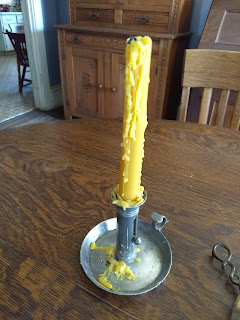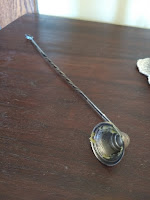 |
| One of our beeswax candles made with stearic acid, showing a typical amount of dripping. Double this for a beeswax/tallow candle, and triple it for pure beeswax. |
Electric everything relies upon a grid fueled by fracked gas, mountaintop-removal coal, uranium (ever wonder why Trump was so hot to get rid of Bear's Ears Monument?), and a host of other nasties. Suffice it to say that electricity production has contaminated much of the planet now to the point where the biosphere is crumbling before our eyes, and our best chance for survival depends on getting rid of it wherever we can.
As the book explains, it's not necessary to sleep for 12 hours a day because you can't have electric lights on all the time, but it is important to average at least 9.5 hours of very low or no light. It's quite possible to exist on dimmer light than we're used to, and it benefits us considerably when we do.
My own lighting goals are 1) can be fueled from a homestead without purchased inputs, 2) provides usable quantities of light, 3) doesn't stink up the home or significantly damage the indoor air quality.
 |
| A center-draft, round-wick Rayo lamp |
With that said, in a non-electric environment, oil lamps do have a place. They can give off quite a bit of light, particularly the Aladdin mantle lamps (which are equivalent to a 30 watt bulb). The downside to these is that the light can be quite harsh, and the mantles are slightly radioactive, as well as being fragile and short lived.
Oil lamps do have some benefits over electric lights. Their light is typically much dimmer, and thus provides the benefits noted above. An overlooked benefit is that they're fairly expensive to operate. The downside to greater efficiency (as noted in Jevon's Paradox) means there's an upside to lower efficiency, which is clearly the case with this lighting option. You'll find that you keep one oil lamp burning with you as you move from room to room, instead of leaving multiple lights going throughout the house, and may very well use less energy as a result.
My preference in oil lamps is for the standard round-wick center-draft lamps of the sort historically produced by Bradley and Hubbard or Rayo. These produce plenty of light, with a softer appearance than the mantle lamps, and are cheaper and easier to maintain and keep well tuned.
Candles, though now relegated to purely decorative or "mood" uses nowadays in
 |
| Aladdin lamp with the chimney removed. It uses a burner nearly identical to the Rayo but with the addition of a mantle for increased light |
I'm not a fan of paraffin candles, as paraffin is a coal derivative and thus has little to recommend it over oil lamps. I have a similar opinion of soy candles, which are effectively a product of Monsanto and Exxon. A homestead with a few beehives, however, can supply a significant amount of beeswax. It makes an excellent lighting fuel, smells great, and is also useful for everything from treating leather to lubricating black-powder rifle patches.
Pure beeswax candles, as we've discovered, do have some shortcomings. Beeswax has a relatively low melting point, which causes the candles to dribble and make a mess. This melting can be reduced through addition of tallow in a 50/50 mix, but there will still be significant dripping. The addition of a small amount of stearic acid (as used in commercial candles) considerably reduces the dripping. It's relatively inexpensive and not much is needed, but it must be purchased. So far as I can tell, it cannot be easily produced at home, and I haven't found any substitutes.
Though we have yet to make our own wicks, I do think it would be relatively simple with the use of flax (aka linen), which we've grown in our garden. I see some candles are now sold with a wooden wick, which would also be worth experimenting with.
 |
| Our tin candle mold |
So candles can be messy, which is why I've found that antique candle-holders with a wide-dish base are perfect for collecting melted wax (which can be melted down into new candles). My favorite type has a knob on the side which makes removing the old candle stump a simple task. With these, you just wait until the candle has burned down far enough to warm the metal base (usually brass), at which point the candle stump slides up easily and is replaced with a fresh candle. These bases all seem to be antique, from the era when candles were standard equipment in any home. They're all over Ebay.
Back in the day when I was an involuntary churchgoer, I remember seeing metal "caps" on the top of some of the candles. Just another way for the church to impress the peasants with fancy finery, I thought. I was wrong! These metal caps are called "candle followers", and do serve a useful purpose. They're quite effective at controlling drips, as it turns out. On our beeswax-stearic acid candles, they've completely eliminated dripping. I haven't tested it yet, but I suspect that they may even work with pure beeswax candles, or even beeswax/tallow candles, which would both eliminate the need for stearic acid as well as allow us to significantly extend our beeswax supplies (tallow is easy to produce if you have any sheep, deer, or cows to butcher).
The one shortcoming of candles which remained is that of snuffing. The typical user nowadays just blows out a candle, which leaves a smoldering wick that gives off smoke for a minute, filling a room with stinky partially burned hydrocarbons. Blow a little too hard and you'll spray wax all over too.
 |
| Bell style snuffer |
 |
| Scissor style snuffer |
 |
| My favorite candle holder, with the cone-type snuffer that stores on the handle, also showing one of our candle followers. Note the lack of drips! |
For future experiments, we'll try making up some pure beeswax candles and see if the follower eliminates drips on those. Another thing I'd like to try is a "rush light". These are relatively fast burning (about 15 minutes), made by soaking the foamy-pith of a rush stem with tallow. While I suspect that a candle is still nicer, they seem as if they would be easier to make, particularly if you don't have beeswax.







